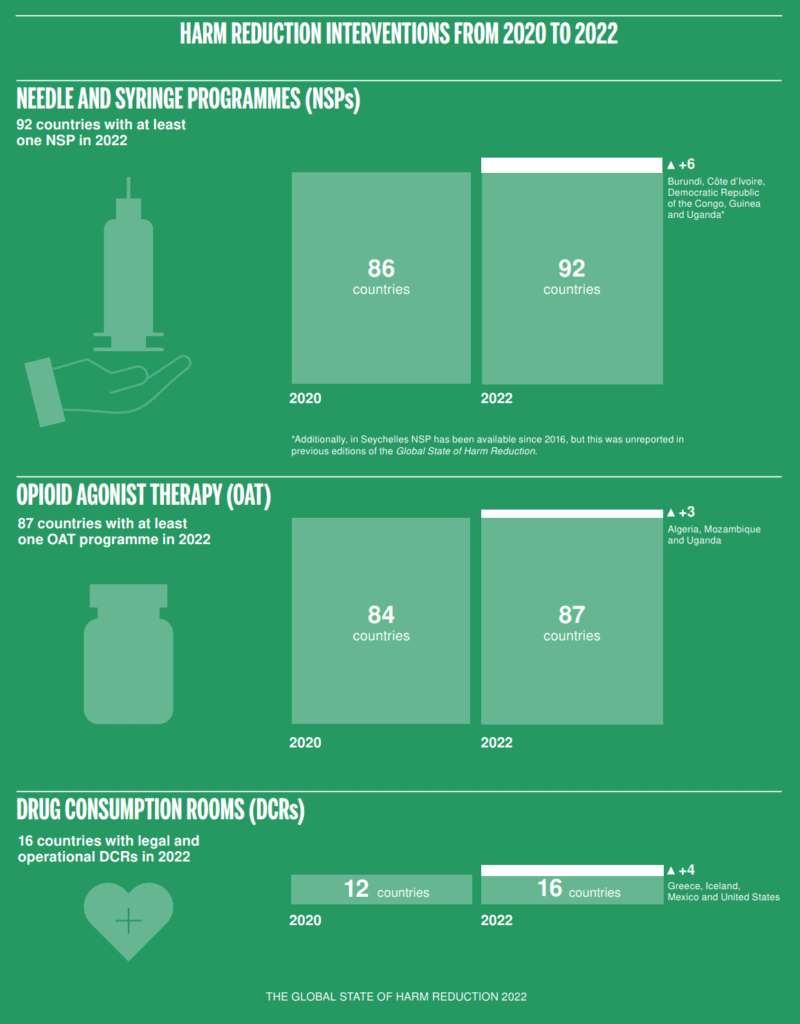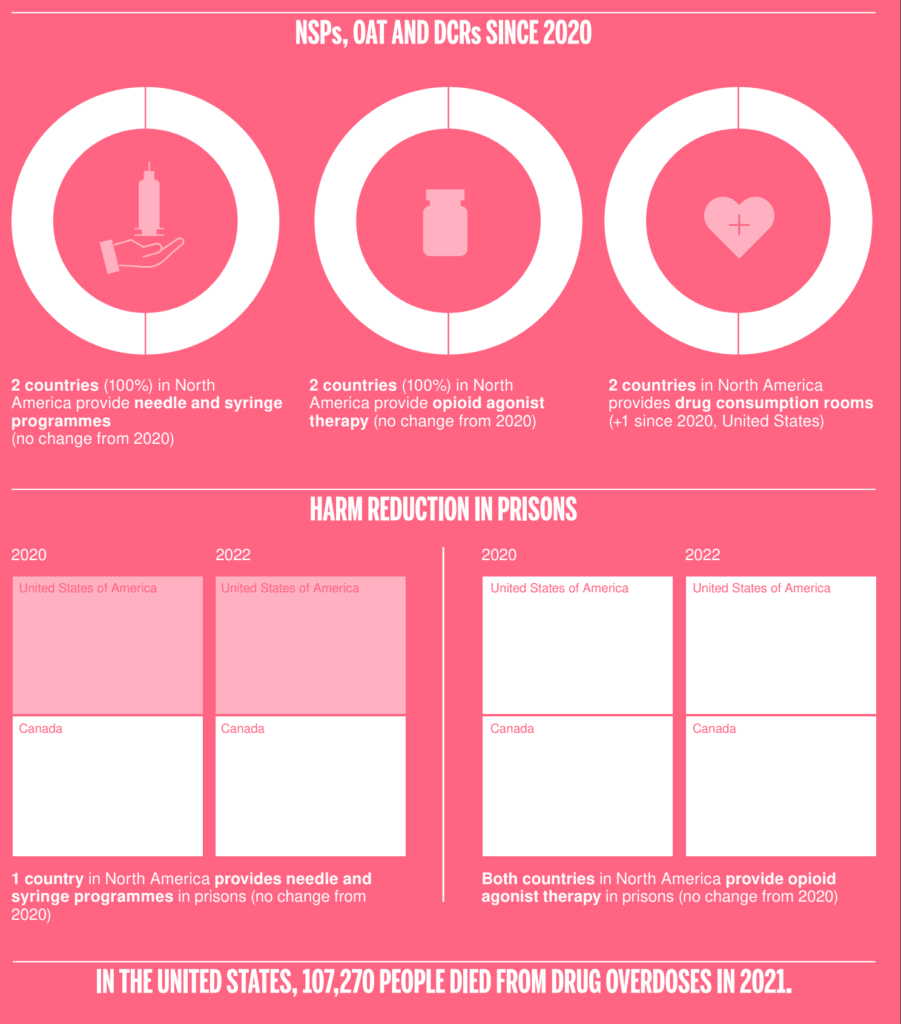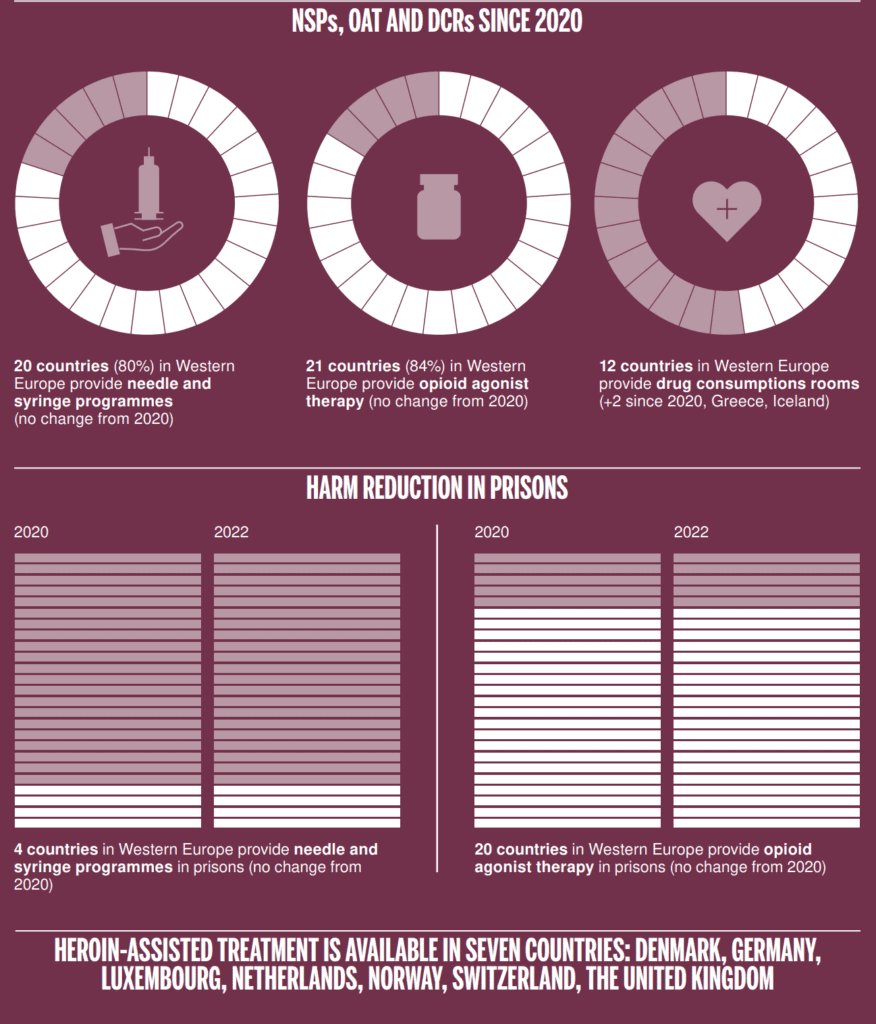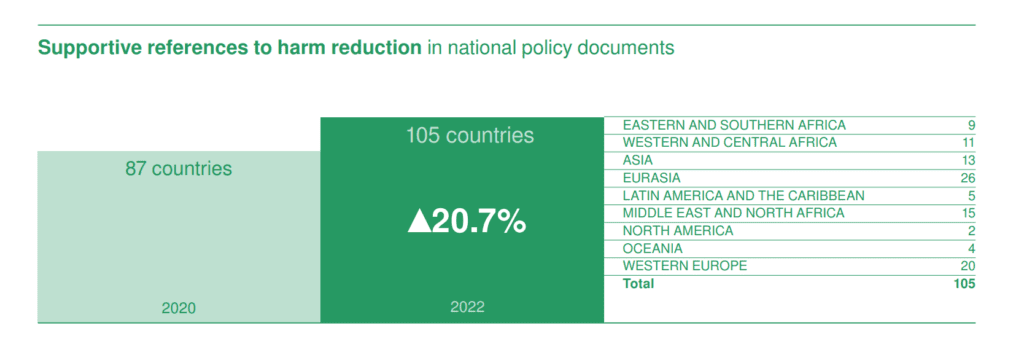The Harm Reduction approach for drugs aims to reduce the negative consequences associated with drug use, such as overdoses, infections, and other health problems, while recognizing that some people may continue to use drugs despite efforts to stop. While Harm Reduction approaches have shown promise in reducing harm and improving health outcomes for some individuals, they are not a cure-all solution for drug addiction and negative consumption. And many doctors, specialists and people who are faced with the dark side of substances are wondering – does harm reduction for drugs work? Let’s figure it out.
What is Harm Reduction Used For?

Of the officially adopted and implemented at the state level in different countries , the following can be noted:
Needle and syringe exchange programs: These programs provide sterile injection equipment to individuals who inject drugs, reducing the risk of infection with blood-borne viruses such as HIV and hepatitis C.
Overdose prevention programs: These programs provide education and training on how to recognize and respond to an opioid overdose, and may distribute naloxone, a medication that can reverse the effects of an opioid overdose.
Safe injection sites: These facilities provide a hygienic environment for individuals to inject drugs under the supervision of trained staff, reducing the risk of overdose, infection, and other health problems.
Medication-assisted treatment (MAT): This approach combines medication, such as methadone or buprenorphine, with counseling and behavioral therapies, to help individuals manage their drug cravings and reduce their risk of overdose and other health problems.
Peer support and counseling: These programs offer emotional support and guidance from individuals who have experienced addiction and are in recovery themselves.
Outreach and education: Last but not least. These programs provide education and awareness about safe drug use practices, such as avoiding mixing drugs, using in the presence of others, and seeking medical attention in the event of an overdose or other health emergency.
Why Harm Reduction Doesn’t Work?

Harm reduction approaches can be ineffective for a variety of reasons. Here are some possible factors:
Formal attitude to the programs both on the part of state systems and health care, and on the part of people who use psychoactive substances or live next to such people. This is one of the biggest barriers to Harm Reduction. Someone approves the measures for their career, someone fulfills this without delving into the essence of the approach, and someone will bring these measures, not believing and not being interested in changing something in their lives. So it doesn’t work and won’t work.
Lack of access to Harm Reduction services: If individuals do not have access to Harm Reduction services, such as needle and syringe exchange programs or MAT, they may not be able to take advantage of these interventions.
Stigma and discrimination: Negative attitudes towards people who use drugs can make it difficult for individuals to access harm reduction services or to feel comfortable using these services. Stigma can also undermine the effectiveness of Harm Reduction interventions by discouraging individuals from seeking care.
Insufficient resources and funding: Harm reduction interventions require resources and funding to be effective. If resources are insufficient or funding is not sustained, harm reduction programs may be limited in their capacity to reach and serve individuals who use drugs.
If you have extra funds, feel free to donate them to the development of local or global harm reduction programs. They almost always work on enthusiasts and need funding.
Lack of integration with other health services: Harm Reduction interventions may be less effective if they are not integrated with other health services, such as primary care, mental health, and social services. This can create barriers to care and limit the impact of harm reduction interventions.
Complexity of drug use: Drug use is complex and multifaceted, and Harm Reduction interventions may not be effective for all individuals or in all circumstances. Some individuals may require more intensive interventions, such as inpatient detoxification or residential treatment, in order to address their substance use disorder.
It is important to note that Harm Reduction approaches are not a panacea and may not be effective in all situations or for all individuals. However, evidence suggests that Harm Reduction interventions can be effective in reducing the negative consequences associated with drug use and improving the health and well-being of individuals who use drugs.
The Numbers Tell The Story

Here I had to give a list of objective data on how the principles of harm reduction work and help people. How they reduce the number of overdoses, infectious diseases, and other consequences for health, happiness and well-being. For example:
- Needle and syringe exchange programs have been shown to reduce the risk of HIV and hepatitis C infection among people who inject drugs by up to 80%.
- Overdose prevention programs: studies found that communities with naloxone distribution programs had more than 25% reduction in opioid overdose deaths compared to communities without such programs.
- Safe injection sites safe injection sites are associated with a reduction in overdose deaths, increased access to health services, and reduced public injection and discarded needles.
- MAT with buprenorphine was associated with a 38% reduction in the risk of overdose death among individuals with opioid use disorder.
- Peer support and counseling were associated with increased retention in treatment and improved outcomes for individuals with substance use disorders.
But most importantly, I want to show you that the process of implementing harm reduction principles is going on right now all over the world. Yes, they mainly concern standard solutions and do not affect all types of narcotic substances and addictive agents, but their gradual adoption at the planetary level shows that Harm Reduction works and will only get better.
Harm Reduction Is Stronger
I really liked this phrase. It characterizes the state of the Harm Reduction approach in 2022 compared to 2020 and early. This is what is noted in the annual colossally important and interesting report The Global State Of Harm Reduction 2022.
The period from 2020 to 2022 has seen increased uptake of harm reduction interventions. For the first time since 2014, the Global State of Harm Reduction
has found an increase in the number of countries implementing key harm reduction services.
- 92 countries implementing at least one Needle and Syringe Program – NSP
(up from 86 in 2020)- 87 countries with at least one Opioid Agonist Therapy – OAT programme
(up from 84 in 2020)- 16 countries with legal and operational Drug Consumption Rooms – DCRs (up from 12 in 2020).
The number of countries providing naloxone on a take-home basis and through peer-distribution models has also increased. Changes in definitions and research strategies make year-on-year comparisons difficult, but the Global State of Harm Reduction 2022 finds there are 35 countries where take-home naloxone is available, and 21 countries operating peer-distribution naloxone programmes.
However, these programmes are often on a very small scale and highly vulnerable to regulatory or funding changes, especially those in low- and middle-income countries such as Iran, Kenya and South Africa. An unprecedented 105 countries are now reported to include supportive references to harm reduction in national policy documents, compared with 87 in 2020.
The overall increase in the commitment to and implementation of harm reduction is a testament to the dedication, resilience and strength of community, civil society and international organisations, which have successfully advocated for a health and human rights-based approach to drug use despite extremely limited resources.
And in addition to what has been said, here are several colorful infographics about the situation in general and individual regions.




More details and data on other regions can be found in the report itself. It is in the public domain. I express my admiration and gratitude to everyone who worked on this document. And also hri.global in general. They are doing a really important job.
Basic conditions for Harm Reduction success
Instead of listing the opposite points to those that were just above, I want to describe here the basic conditions on which any Harm Reduction approach should be based. The table that is presented below is more suitable for the article Harm Reduction Philosophy, but unfortunately I came across this data just now. Or fortunately.
Please note that the table is devoted to the introduction of Harm Reduction practices in medical institutions. And it turns to doctors, describing their patients. However, anyone can read, accept and use these principles. Just replace the word patient with the person. And think about yourself, your loved one, your patient, or your colleague.
| Principle | Definition | Approaches |
| Humanism | Providers value, care for, respect, and dignify patients as individuals. It is important to recognize that people do things for a reason; harmful health behaviors provide some benefit to the individual and those benefits must be assessed and acknowledged to understand the balance between harms and benefits. Understanding why patients make decisions is empowering for providers. | Moral judgments made against patients do not produce positive health outcomes. Grudges are not held against patients. Services are user-friendly and responsive to patients’ needs. Providers accept patients’ choices. |
| Pragmatism | None of us will ever achieve perfect health behaviors. Health behaviors and the ability to change them are influenced by social and community norms; behaviors do not occur within a vacuum. | Abstinence is neither prioritized nor assumed to be the goal of the patient. A range of supportive approaches is provided. Care messages should be about actual harms to patients as opposed to moral or societal standards. It is valuable for providers to understand that harm reduction can present experiences of moral ambiguity, since they are essentially supporting individuals in health behaviors that are likely to result in negative health outcomes |
| Individualism | Every person presents with his/her own needs and strengths. People present with spectrums of harm and receptivity and therefore require a spectrum of intervention options. | Strengths and needs are assessed for each patient, and no assumptions are made based on harmful health behaviors. There is not a universal application of protocol or messaging for patients. Instead, providers tailor messages and interventions for each patient and maximize treatment options for each patient served. |
| Autonomy | Though providers offer suggestions and education regarding patients’ medications and treatment options, individuals ultimately make their own choices about medications, treatment, and health behaviors to the best of their abilities, beliefs, and priorities. | Provider-patient partnerships are important, and these are exemplified by patient-driven care, shared decision-making, and reciprocal learning. Care negotiations are based on the current state of the patient |
| Incrementalism | Any positive change is a step toward improved health, and positive change can take years. It is important to understand and plan for backward movements. | Providers can help patients celebrate any positive movement. It is important to recognize that at times, all people experience plateaus or negative trajectories. Providing positive reinforcement is valuable. |
| Accountability without termination | Patients are responsible for their choices and health behaviors. Patients are not “fired” for not achieving goals. Individuals have the right to make harmful health decisions, and providers can still help them to understand that the consequences are their own. | While helping patients to understand the impact of their choices and behaviors is valuable, backwards movement is not penalized. |
Conclusion

Harm Reduction is an approach that seeks to minimize the negative consequences associated with drug use while recognizing that drug use may be an unavoidable reality for some individuals. Harm Reduction interventions include a range of strategies.
Scientific evidence supports the effectiveness of Harm Reduction in reducing the harms associated with drug use and improving the health and well-being of individuals who use drugs. However, it is not a one-size-fits-all approach, and interventions should be tailored to meet the individual’s needs and circumstances.
Using an analogy, we can say that we have just got out of the water on land, and now we are waiting for a long evolution until the moment when Harm Reduction becomes as basic a part of human society as the rules of the road. We must strive for this. Otherwise, addictions and dysfunctional relationships with substances will ruin us. But already today I see how slowly, but together we are moving in the right direction.
✔️
This marks the finish of today’s session. It is my hope that this piece was enlightening.
If you desire to advance the growth of this blog, I suggest the following actions:
- Subscribe to our social networks.
- Circulate a link to this article among your associates.
- Give recognition to this blog on relevant platforms or discussion groups.
Should you identify any necessary additions or corrections in this article, feel free to initiate a dialogue with me via Contact Form. I am always open to communication.
I appreciate your valuable time and consideration ☀️




